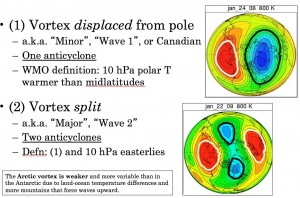Sudden Stratospheric Warmings
Sudden stratospheric warmings (SSWs) occur when tropospheric planetary waves propagate up into the stratosphere, break, and deposit energy and momentum. SSWs result in disruptions to the typical wintertime circumpolar circulation (see Polar Vortex section). When planetary waves (with wave numbers of 1 or 2) deposit their momentum, the polar night jet slows down and even reverses. Following a deceleration in the flow, convergence over the pole results in enhanced descent and warming. The warming is so rapid and dramatic (50 K over 2 days) that it is like going from Siberia to the Sahara. SSWs cause a ripple effect and are linked to cooling in the mesosphere, warming in the thermosphere, anomalies in the ionosphere, and anomalous weather patterns in the troposphere.
The figure below illustrates the two types of SSWs. The first shows the vortex (black contour) displaced from the pole by a large anticyclone (white contour). The second shows the vortex split into two cyclonic lobes. SSWs are a regularly occurring phenomenon in the Arctic. Only one vortex split has ever occurred in the Antarctic (in 2002).





